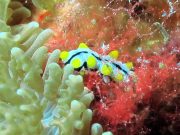Dykning med Holothuriidae Sjögurkor
Lanta Marina Liv | Holothuriidae
Holothuriidae-familjen med cirka 185 sjögurkor, varav flera vi kan hitta i överflöd när vi dyker från Koh Lanta.
Holothuriidae sjögurkor har tjocka köttiga kroppar, allt från små till mycket stora, ofta täckta med små rundade utsprång som kallas papiller. Alla arter har många rörliknande fötter på underkroppen och flera arter har 15-30 tentakler i munnen.
Vid stress eller angrepp kan många medlemmar av denna familj skjuta ut många fina klibbiga vita trådar från anus, så kallade Cuvierian Tubules. Dessa rör kan trassla in sig och oskadliggöra ett rovdjur. Röret kan lossas invändigt och sedan växa ut igen inom 2-4 veckor.
Beroende på art kan sjögurkor vara dolda under stenar och bråte, begravda i sand, ligga exponerade eller i vissa fall aktivt röra sig runt ett korallrev med sina rader av klibbiga rörfötter. Några få arter är aktiva under dagen, men de flesta är aktiva på natten.
4 arter finns på denna sida:
Elephant trunkfish
(Holothuria fuscopunctata)
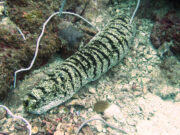
Holothuria fuscopunctata @ Koh Haa
The Elephant trunkfish is a large sea cucumber with a thick body wall, generally golden-brown with dark spots and dark brown wrinkles along its entire body length.
The underside is whitish, the mouth being surrounded by twenty thick brown tentacles and the anus surrounded by a black band.
This sea cucumber can reach up to 70 cm and can weigh up to 4.5kg, though it’s spotted around Lanta more commonly in the 30 - 50 cm range.
This species is normally found down to 30 m, is slow to mature and has a low fertility rate.
Graeffe's Sea Cucumber
(Pearsonothuria graeffei)
The Graeffe's Sea Cucumber is one of the most common sea cucumbers encountered at the dive sites around Koh Lanta. This species of sea cucumber has a white body, with many light, thorny projections surrounded by pale brown blotches. There are many small dark spots all over the body and hundreds of small tube feet on the lower body.
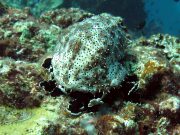
Adult Pearsonothuria graeffei @ Koh Haa
Around the mouth are around 20 - 24 tentacles comprising black stalks with leaf-like ends. The leaves are black on the top and white on the bottom and help to ‘feel’ the way around the coral reef.
This species grows up to 30 cm, are very light-weight and are very thin-walled and ‘floppy’ if picked up (we have rescued some from a fishing trap, but do not recommend touching any marine life in the course of a normal dive).
Small juvenile Graeffe's Sea Cucumbers mimic the phyllidiid sea slug Phyllidia varicosa for protection (many nudibranchs are poisonous and distasteful to predators), and as they grow larger than the nudibranch they are impersonating, they start to take on the adult sea cucumber colouration and form. (see photos)
Pinkfish Sea Cucumber
(Holothuria edulis)
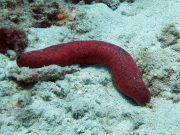
Holothuria edulis @ Koh Rok
The Pinkfish Sea Cucumber has a reddish-pink cylindrical body with rounded ends. There is sometimes a black area on the back/upper body, however this species can also be other colours, such as grey or dark brown.
The lower body has rows of small tube feet which help with movement, and which can be retracted into the body if necessary.
There are around 20 oral tentacles which can help with feeding, movement and also righting itself if it is overturned.
The Pinkfish Sea Cucumber grows to 35 cm and is found over sand and rubble is shallow areas of coral reefs.
Blue Sea Cucumber
(Actinopyga caerulea)
The Blue Sea Cucumber has a loaf-shaped body with some tapering toward each end. The body colour is mostly bluish, with white patches. The bluish areas are covered with small conical 'papillae', which are absent in the white areas.
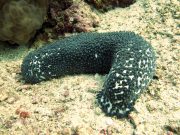
Actinopyga caerulea @ Koh Haa
The mouth of a Blue Sea Cucumber is on the bottom, surrounded by 15 to 18 large bluish-grey tentacles, which in turn are surrounded by a collar of bluish papillae.
The anus of the Blue Sea Cucumber is at the rear end, surrounded by 5 white anal teeth.
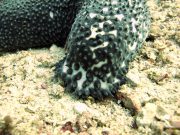
Actinopyga caerulea @ Koh Haa
Unlike many other members of the family Holothuriidae, the Cuvierian organ is absent in Blue Sea Cucumbers and this species is unable to eject Cuvieran tubules if stressed.
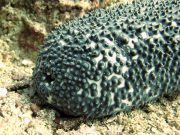
Actinopyga caerulea @ Koh Haa
Dykning med Holothuriidae Sjögurkor runt Koh Lanta
Dykning och Snorkelutflykter
Om du vill ha en chans att se Holothuriidae Sjögurkor på en av våra dagliga högsäsongs dykresor från Koh Lanta, skicka oss ett e-postmeddelande till info@diveandrelax.com.
Följ med på våra dykresor med speedboat under högsäsong till några av Thailands bästa dykplatser och njut av små grupper, korta restider och fokus på personlig service, säkerhet och nöje.
Är du ännu inte certifierad dykare? Lär dig att dyka på Koh Lanta med den 3-dagars SSI Open Water Diver-kursen.
Boka online och spara 10 % på dykresor och dykkurser på Koh Lanta.
Ta Reda på Mer
Guider för Marina Djur och Växter i Indo-Stilla Havet
- Allen, G., Steene, R., Humann, P., DeLoach, N. (2003) Reef Fish Identification, Tropical Pacific. Jacksonville, FL., USA: New World Publications, Inc., ISBN 1-878348-36-1.
- Humann, P., DeLoach, N., (2010) Reef Creature Identification, Tropical Pacific. Jacksonville, FL., USA: New World Publications Inc., ISBN 978-1-878348-44-9
- Debelius, H. (2013) Indian Ocean Reef Guide. Frankfurt, Germany: IKAN - Unterwasserarchiv, ISBN 978-3-939767-52-7.
- Debelius, H. (2004) Nudibranchs and Sea Snails, Indo-Pacific Field Guide. Frankfurt, Germany: IKAN - Unterwasserarchiv, ISBN 3-925919-51-1
- Erhardt, H., Knop, D. (2015) Corals Indo-Pacific Field Guide. Frankfurt, Germany: IKAN - Unterwasserarchiv, ISBN 3-925919-69-4.
- Veron J.E.N., Stafford-Smith M.G., Turak E. and DeVantier L.M. (2016). Corals of the World


